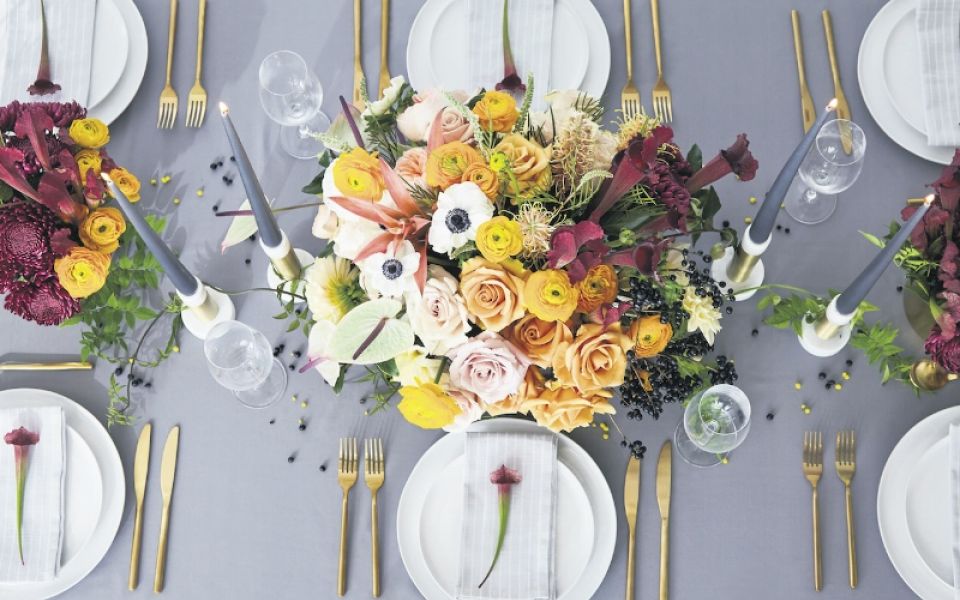Interiors: Inside the newly-opened London Flower School and why the capital is the home of floral artistry

In King’s Cross, the newly-opened London Flower School is bustling with Chinese students indulging their passion for plants. Floral art is so big in Asia that up to 80 per cent of students at UK flower schools arrive from China, Korea and Japan. Why do they come so far? Because London is the world leader in floral art.
At least that’s what MD Wagner Kreusch and CEO Helen Dyson, tell me, who run the school and teach in it, too. “London is where it’s at,” Dyson says, referring not just to floral art but to food, fashion and the gamut of creative industries. She has lived in New York, but says that London now beats anywhere else hands down as the place to open a creative business.
“People come to London with the expectation of finding cutting edge things and creative people,” Kreusch says. Constance Spry may have been the go-to name in Mayfair in the 1930s, but today’s flower schools, such as Jane Packer and McQueens, are also household names; McQueens’ reputation even reaches across the Atlantic, where it dresses the Vanity Fair Oscar party every year.
Whether you are looking to commission a floral artist for a special occasion, a weekly display or you feel creative yourself, there’s so much more to discover than froths of orchids. And all this floral exuberance, skill and artistry has been going on for decades under our noses – you only need visit Neill Strain, a florist in Belgravia, to see cutting-edge opulence and theatricality at work.

A class at London Flower School
Yet now, two of our most popular trends have come together to shine a spotlight on it – bringing the outside in, whether that’s leafy prints or a living wall, and the resurgence of making and craft. Now is the perfect moment to open a flower school.
Courses at LFS range from one or two days (floristry in its context of colour, texture and form, with plenty of practice, techniques and tips), to one or two weeks; and then there’s the career course. From an educational standpoint, LFS is about depth and exposing the student to all styles, not just a house-style, loosening up creativity, and discovering artistry rather than mimicry.
“People come to London with the expectation of finding cutting edge things and creative people”
When I visited, I tried a hand-tied bouquet, stripping the stems of foliage to lessen the bacteria while in water, which we should change every couple of days for longevity, apparently. I bunched foliage around a central bloom, adding in roses above the greenery so that the focal flowers were not lost, and then completed the arrangement with smaller flowers to sit around the rim of the vase.
I was pleased with my handiwork, but it wasn’t until I put them in water at home that I realised how stunning it really looked. Polished, professional – yet, relaxed and uncontrived, as if I’d picked them straight from my English cottage garden. And they made the whole house smell divine.

Mulberry catwalk, with flowers by McQueen's of London
You can pick up armfuls of affordable blooms from a trip to Columbia Road, but you’ll find the best choice at the New Covent Garden Market in Vauxhall, says Rachel Bull, editor of The Flower Arranger magazine. The traders sell to the public as well as florists, but you’ll get the best prices when they get to know your face.
“There’s always been a huge interest in floral art,” Bull says. “Our members within the National Association of Flower Arrangement Societies have been creating gold-medal-winning designs at Chelsea for decades.
The international scene is going strong, with a host of younger floral designers and master florists from Europe and Asia establishing names for themselves by creating incredible floral art on huge scales.” London’s floral industry is in full bloom. Let’s hope it continues to grow.
London Flower School can be found at 16-20 Wharfdale Road, London N1 (londonflowerschool.com). For London events visit flowerarranginglondon.org.uk; for British flowers visit thebritishflowercollective.com